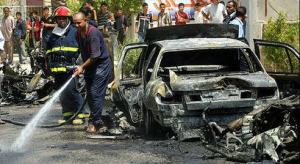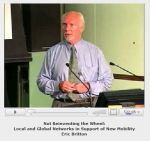I was thinking that, since the concept of “slow” has been around for a while, but applied to concepts such as food and “living” in general, one could think of  applying it to transport policies and projects… that is, create the term “slow transport” or “slower transport”, but responsibly. Below are some notes that could generate ideas towards that direction: where the concept comes from, why and how we can apply it, and some obstacles or possible problems. I will be as brief as possible, since I could write for ages about this. My main concern would be to develop a (or yet another) way of justifying the promotion and development of sustainable transport. And my main worry is that we could just generate a new empty term related to urban transport (we have enough already).
applying it to transport policies and projects… that is, create the term “slow transport” or “slower transport”, but responsibly. Below are some notes that could generate ideas towards that direction: where the concept comes from, why and how we can apply it, and some obstacles or possible problems. I will be as brief as possible, since I could write for ages about this. My main concern would be to develop a (or yet another) way of justifying the promotion and development of sustainable transport. And my main worry is that we could just generate a new empty term related to urban transport (we have enough already).
Monday, January 30, 2012
Carlos Pardo: On Slow(er) transport?
Saturday, January 28, 2012
Book report: Sustainable Transportation Planning
Michael Alba reports from Boston on this new guide for transport planners: Sustainable Transportation Planning seeks to tackle the greatest social and environmental concerns of the 21st century, focusing on the role of transportation in creating more sustainable communities. It is a how-to guide for anyone interested in the economic, social and ecological health of cities.
Sustainable Transportation Planning seeks to tackle the greatest social and environmental concerns of the 21st century, focusing on the role of transportation in creating more sustainable communities. It is a how-to guide for anyone interested in the economic, social and ecological health of cities.
Friday, January 27, 2012
Getting outside that box (which may require being just a bit unreasonable)
 Once we are cozily set up in our box -- a box of course that we can neither see nor really appreciate (What box?) -- we become accustomed to thinking of things comfortably wedged within our invisible container as "that's the way things are". And from there it is a very small step to become a pragmatically "reasonable person". To which I can only quote Bernard Shaw when he said so long ago (with social justice and the emancipation of women firmly in the middle of his sites): The reasonable man adapts himself to the world; the unreasonable one persists in trying to adapt the world to himself. Therefore all progress depends on the unreasonable man. Let's see if Preston Schiller can help us to get outside the box of the automobile.
Once we are cozily set up in our box -- a box of course that we can neither see nor really appreciate (What box?) -- we become accustomed to thinking of things comfortably wedged within our invisible container as "that's the way things are". And from there it is a very small step to become a pragmatically "reasonable person". To which I can only quote Bernard Shaw when he said so long ago (with social justice and the emancipation of women firmly in the middle of his sites): The reasonable man adapts himself to the world; the unreasonable one persists in trying to adapt the world to himself. Therefore all progress depends on the unreasonable man. Let's see if Preston Schiller can help us to get outside the box of the automobile.
Thursday, January 26, 2012
Story-telling time at World Streets
 The readers of World Streets will, I am sure, have little difficulty putting this old tale by Edgar Allan Poe right into our 21st century context: climatic, environmental, economic, social and human. As we dance dance dance.
The readers of World Streets will, I am sure, have little difficulty putting this old tale by Edgar Allan Poe right into our 21st century context: climatic, environmental, economic, social and human. As we dance dance dance.
Wednesday, January 25, 2012
Groningen: The quiet example
 What? You know all about transport in cities and you have never heard of Groningen? Well, check out this : an unexpected street interview in Groningen, a slice of life as filmed by our old friend and transport innovating colleague Robert Stussi. He has titled it: "A Homage to Hans Monderman". Hear, hear!
What? You know all about transport in cities and you have never heard of Groningen? Well, check out this : an unexpected street interview in Groningen, a slice of life as filmed by our old friend and transport innovating colleague Robert Stussi. He has titled it: "A Homage to Hans Monderman". Hear, hear!
Tuesday, January 24, 2012
Whenever I hear the word revolver . . . I reach for my culture.
 We have long-held a theory at the New Mobility Agenda that you can never tell where the next good idea is going to come from. So you really do have to keep your eyes, ears and minds wide open, and learn where you can, where you can, from whom you can. For example, Volkswagen in the New Mobility Agenda? Well, what not? Let's show you one great idea that you may not have seen the first time around and that we have just this morning plucked out from our archives.
We have long-held a theory at the New Mobility Agenda that you can never tell where the next good idea is going to come from. So you really do have to keep your eyes, ears and minds wide open, and learn where you can, where you can, from whom you can. For example, Volkswagen in the New Mobility Agenda? Well, what not? Let's show you one great idea that you may not have seen the first time around and that we have just this morning plucked out from our archives.
Monday, January 23, 2012
EQUITY/TRANSPORT READING ROOM. V1

Here you have the beginning of a basically unstructured reading list of articles and books that dig from a wide variety of angles into the complex but oh so important issues that underlie the concept of an equity-based transport systems and policy. In time we will organize this with greater rigor and more detail (but not too much, time is so important), but here you have it today as a useful first reference point, in addition to those you have yourself.
Friday, January 20, 2012
Charina Cabrido reports on SAFA Tempos (Electric three-wheelers) in Nepal
SAFA tempos or Nepal’s version of electric three wheelers are typically seen in  Kathmandu’s busy streets. Running at an average speed of 60 kilometer per hour, safa tempos serve at least 127 thousand people everyday transporting individuals to their destinations. This is quite a challenge for a country that has been constantly confronted with power cuts that reach sixteen hours a day especially during winter season.
Kathmandu’s busy streets. Running at an average speed of 60 kilometer per hour, safa tempos serve at least 127 thousand people everyday transporting individuals to their destinations. This is quite a challenge for a country that has been constantly confronted with power cuts that reach sixteen hours a day especially during winter season.
Safer Streets LA - Wrap a couple of spare neurons around this one
 From the 2012 Safe Streets Challenge project:
From the 2012 Safe Streets Challenge project:
If you are (a) into safer streets and (b) ready to dig in to understand that things out there are not necessarily what one might necessarily think, may we suggest that you check out here this slightly counterintuitive piece that was posted this morning in our parallel Safe Streets project.
Thursday, January 19, 2012
Roads vs. Streets: Wherein the greater danger?
 Michael Blastland plays around with some statistics, usefully!, on roads vs. streets when it comes to accidents and safety in this article that appeared in today's BBC magazine. (Click here for his article in full and here for the often quite stinging comments that it has triggered.) Ours here is quite another focus, but it is interesting to keep our eyes open for short pieces like this.
Michael Blastland plays around with some statistics, usefully!, on roads vs. streets when it comes to accidents and safety in this article that appeared in today's BBC magazine. (Click here for his article in full and here for the often quite stinging comments that it has triggered.) Ours here is quite another focus, but it is interesting to keep our eyes open for short pieces like this.
Wednesday, January 18, 2012
Op-Ed: What/who keeps holding back New Mobility reform?
 If you get it, New Mobility is a no-brainer. However, while the New Mobility Agenda is a great starting place, it is not going to get the job somehow miraculously done just because it is the only game in town when it comes to sustainable transport. There is plenty of competition for all that space on the street and between the ears. We have a few potential sticking points here that need to be overcome first. Let's have a quick look to get this exchange off the ground. After some years of talking with cities, and working and observing in many different circumstances, here is my personal shortlist of the barriers are most frequently encountered in trying to get innovative transportation reform programs off the ground, including even in cities that really do need a major mobility overhaul.
If you get it, New Mobility is a no-brainer. However, while the New Mobility Agenda is a great starting place, it is not going to get the job somehow miraculously done just because it is the only game in town when it comes to sustainable transport. There is plenty of competition for all that space on the street and between the ears. We have a few potential sticking points here that need to be overcome first. Let's have a quick look to get this exchange off the ground. After some years of talking with cities, and working and observing in many different circumstances, here is my personal shortlist of the barriers are most frequently encountered in trying to get innovative transportation reform programs off the ground, including even in cities that really do need a major mobility overhaul.
Monday, January 16, 2012
Op-Ed: A rethinking of what parking is in the first place
 "If your parking policy debates are going in circles, there is a good chance the protagonists are 'framing' parking in totally different ways." (Let's see what Paul Barter of Reinventing Parking had to say on this earlier today in Singapore.)
"If your parking policy debates are going in circles, there is a good chance the protagonists are 'framing' parking in totally different ways." (Let's see what Paul Barter of Reinventing Parking had to say on this earlier today in Singapore.)
Saturday, January 14, 2012
Honk! Getting off the ox (when it comes to cars and cities).

There is a bit of ancient Hindu wisdom that goes, roughly: How can a man riding an ox and looking for an ox, ever find the ox. The answer being of course, only when he gets off the ox. Thus it is in life, but for many of us it is somewhere between hard and impossible to ever get off the ox of our perceptions and set values. But there are, thankfully, creative people who can do this.
Here by way of a quick warm-up is one quick demonstration of this off-the-ox approach from the lively mind of Jean Tinguely of his Cyclograveur, in short a bicycle that, as you pant and pedal, paints beautiful (?!?) pictures. And now t for your weekend reading pleasure let's have a look at what our friends over at Streetsblog have just reported on another more timely off-the-ox transportation project, this time by the ever-ingenious Chris Burden with his post-Tinguely road-wrapping machine, Metropolis II. Off we go.
Friday, January 13, 2012
John W. Verity on New Scare City
 It's a fictional streetscape we wander, here, a metropolis whose buildings, boulevards, and back alleys are in a constant state of flux. This is every place, and yet, no place at all - a city of dreams and a dream of a city.
It's a fictional streetscape we wander, here, a metropolis whose buildings, boulevards, and back alleys are in a constant state of flux. This is every place, and yet, no place at all - a city of dreams and a dream of a city.
Saturday, January 7, 2012
What happened with Kampala's first-ever Car Free Day in 2011
 It started like a dream, and became a reality. After the long awaited workshop in April this year, some major steps have been taken so far in Kampala. By the end of the workshop which was organized and financed by Kampala Capital City Authority in association with Goudappel Coffeng, Goudappel Africa and Iganga Foundation, a pilot project was prepared by the same partners. With its artistic impressions, Kampala looked like a heavenly city, with the people friendly infrastructure in place.
It started like a dream, and became a reality. After the long awaited workshop in April this year, some major steps have been taken so far in Kampala. By the end of the workshop which was organized and financed by Kampala Capital City Authority in association with Goudappel Coffeng, Goudappel Africa and Iganga Foundation, a pilot project was prepared by the same partners. With its artistic impressions, Kampala looked like a heavenly city, with the people friendly infrastructure in place.


